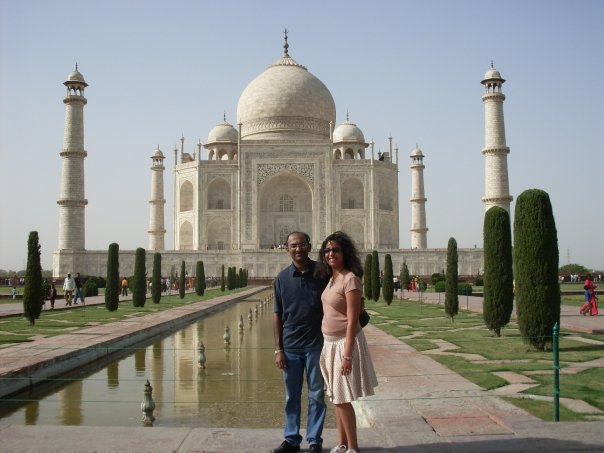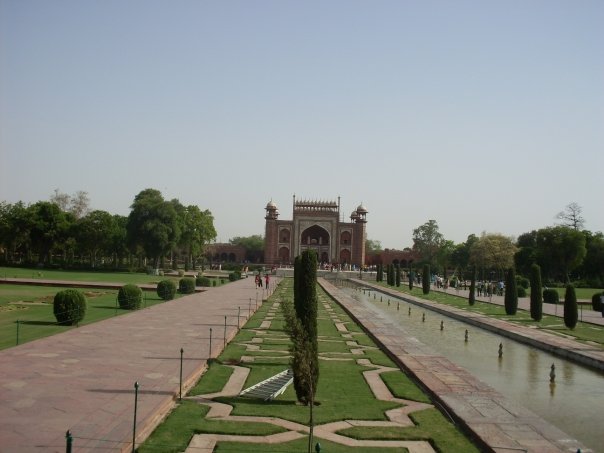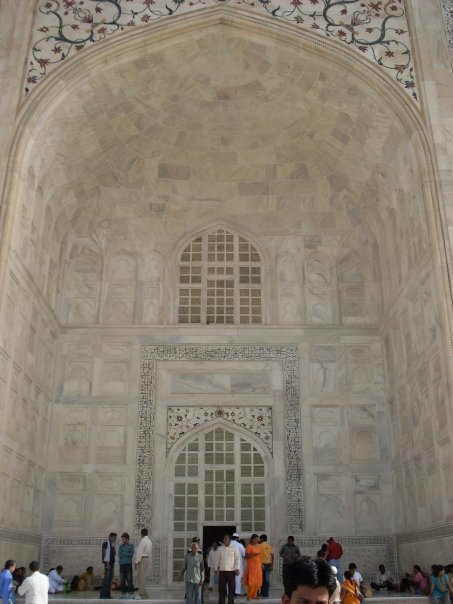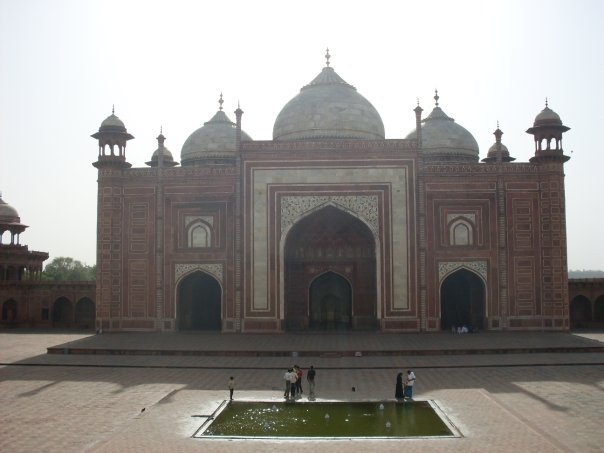
Thursday was India’s Independence Day, so in honor of this great country, I decided that this week’s blog post would highlight someplace in India. Today, I will spotlight perhaps the country’s best known and most visited tourist attraction, the Taj Mahal. When people book tours or vacations to India, this is the place that is typically at the top of everyone’s list, and is regarded as one of the wonders of the world. It is also regarded as something of an unofficial symbol of India.
History and Layout
First, a little history about the place. Some mistakenly think of the Taj Mahal as a palace, but in fact, it is a mausoleum, constructed from 1648-1653 by the Mughal emperor Shah Jahan in honor of his late wife, Mumtaz Mahal. The main building was constructed almost entirely of white marble, inlaid with precious stones in places, though the entire complex was surrounded by stone walls and gates constructed of red sandstone. The complex reportedly fell into a state of disrepair by the 19th century, but was eventually restored, and was declared a UNESCO World Heritage Site in 1983.
When most people think of the Taj Mahal, they think of the white marble monument itself that you typically find on postcards, such as the photo at the top of this blog post, but there is actually a lot more to it, and you’re missing out if that’s all you come to see! The Taj Mahal actually consists of several distinct structures and features, the main ones being the Great Gate, the Taj Mahal itself which contains the tomb of Mumtaz Mahal, a mosque, and the ornamental gardens. The main Taj Mahal features four minarets, a common feature of Mughal architecture of the period (for another example, see the Charminar monument in Hyderabad).
A Virtual Photo Tour
Don’t take my word for it, though – I’ll let the photos do the talking on this virtual tour. Just keep in mind that all of this was built in the 17th century, without the benefit of modern equipment or tools, which makes the structure all the more remarkable. First up is the Great Gate, as you enter the Taj Mahal.
You are almost immediately greeted by the Mahal itself, with a stunning reflection in the reflecting pool on a sunny day. If you are traveling with a significant other, this is probably the best spot to take a photo together.
From here, you can turn around and get a good view of the Great Gate.
Once you walk up to the top of the steps, you are afforded a nice view of the Yamuna River, with Agra Fort partially visible on the left. Don’t even think about swimming in here, though.
A close-up of the intricate marble work of the Taj Mahal, at the entrance to the tomb itself. Unfortunately, photography is prohibited inside the tomb, so no photos to share.
Once you tour the inside of the tomb, you are afforded a view of the mosque (as I recall, you can’t go inside).
Here is a close-up of the artwork in the marble of the main building.
And finally, a view of the garden from the top of the steps in front of the tomb building.
Getting to the Taj Mahal
The Taj Mahal is located in the city of Agra, in the state of Uttar Pradesh, approximately 200 kilometers south of Delhi. The most common way of getting here is to fly to Delhi, and then arrange a car and driver to make the rest of the trip. It is a grueling 5-hour drive from Delhi, though supposedly, a new expressway is open or will soon be opened that will cut travel time in about half (it had not been constructed when we visited in 2009). You can usually arrange a tour guide and vehicle through a travel agent that specializes in India, or can take your chances and try to arrange one when you land at the Delhi airport. Generally, you will pay between $20 and $50 per day for the car and driver, depending on the type of vehicle you want and the number of people in your group.
You can also travel by inter-city bus (not recommended) or by train from Delhi. Numerous local and express trains run between Delhi and Agra, with travel times ranging between 3 and 6 hours,
with fares in an A/C compartment ranging from $15-25 per person one way. Check the Indian Railways website for full schedules and fares; unfortunately, foreign credit cards or bank accounts are not accepted for payment, so you’ll have to either call a travel agent or try your luck once you get to India if you want to take the train.
Finally, Air India (http://www.airindia.com) does offer flights from Delhi to Agra, for about $60 per person one way. However, flights only run 3 days a
week, so double check and make sure that the planes are running on the day you plan to be in Agra, and more importantly, on the day you plan to return. Air India also has a history for spotty
service and timekeeping, so keep that in mind.
How Much It Costs to Tour the Taj Mahal
Back in 2009, entrance fees were 750 rupees ($12.50 at today’s exchange rates) for foreigners, or 100 rupees ($1.60) for Indian nationals, or in our case, people who look local enough to fool the ticket taker. I would imagine the fees are pretty similar today, as historically, India hasn’t exactly updated its prices on a regular basis. Regardless, entrance is a bargain, relatively speaking.
Unless you have friends or relatives in Agra that you plan to stay with and have help get you around, I would recommend arranging a tour through your hotel if you are spending the night in Agra, or through a travel agent if you are driving, taking the train, etc. from Delhi. Your tour guide will take care of obtaining tickets, and give you a thorough tour of the premises at your own pace. If you have arranged a “package tour” in advance that includes other sites in Agra or Delhi, the cost of the tour guide will be included in the package price, though the tour guide (as with pretty much everyone else in India) will expect a tip. The going gringo rate is about 250 rupees per person.
If you’re feeling adventurous, you can just have a taxi or your driver drop you off at the entrance, and hire a tour guide at the gate. If you go this route, MAKE SURE TO NEGOTIATE A PRICE BEFORE GETTING STARTED; otherwise, you could be in for a rude surprise when the guide demands an outrageous sum of money at the end. Guides at the Taj Mahal are more expensive than other tourist sites, but you still shouldn’t pay more than 500 rupees per person. Start out at, say, 200 per person, and go from there.
Once you get inside, beware that hawkers will attempt to entice you to be your personal photographer during your tour. They will take nice photos, but again, remember that you will be charged for the privilege, so negotiate a price upfront. We once got burned in Shimla by this scheme, and had to cough up 3,600 rupees for a bunch of (admittedly nice) photos.
Where to Stay Near the Taj Mahal
Two hotels in Agra tend to be considered THE places to stay if you want to overnight in Agra. The Taj Group offers The Gateway Hotel, located approximately 3 km from the Taj Mahal. Prices currently range from $70-150 per night, with prices generally lower during monsoon season (June-September). If you REALLY want to treat yourself, the famous Oberoi Amarvilas offers stunning views of the Taj Mahal right from your room – but you will pay for the experience, with prices ranging from $265-625 a night, depending on the season. If neither place strikes your fancy, there are a multitude of 3-4 star, Western-quality hotels that you can get for less money; contact a travel agent that specializes in India for more details.
When to Visit the Taj Mahal
The best time to visit is November through February, when the nights are cool, the days are pleasant, and rainfall is rare. By far the best month to visit is January, when daytime highs
in the 70s make for a pleasant walk around the gardens (however, beware of fog in Delhi, which can cause major delays with air and rail transport). April through mid-June tend to be extremely
hot, with afternoon temperatures often exceeding 110 degrees, and crowds tend to be an issue because it coincides with summer school holidays. Monsoon season (mid-June through September) is
actually a good time to visit. Crowds are smaller, hotel prices are much cheaper, and this far inland, you’re more likely to run in to an occasional afternoon thunderstorm than anything
else. Of course, if you get unlucky, you could end up in town the 2-3 days per month that it rains continuously the whole day.
Dawn is generally regarded as the best time to visit the Taj Mahal, as the early morning light produces unique colorations and shadows among the buildings. Be aware, though, that this means
arriving at the Taj in the neighborhood of 5:30 A.M. If you aren’t a morning person, plan accordingly.
Other Things to Consider
Be especially cautious outside of the Taj Mahal grounds. In addition to being a dump in general, Agra has quite possibly the most aggressive collection of beggars and hawkers anywhere in
India. We were followed for a good quarter mile by both someone trying to sell us a carriage ride, and someone trying to sell costume jewelry, which was an unnerving experience. Stay in
groups and just keep walking if a hawker tries to bother you.
In addition, as is the case pretty much everywhere in India, your driver will take you to a carpet shop, a jewelry shop, a curio shop, or a combination of the two at some point during your
trip. Sometimes you can get good stuff, but remember that your driver is receiving a kickback from everything you buy, so shop accordingly. It goes without saying, NEVER pay list price;
start off at least 50-60% less than what the tag says.
And of course, drink only bottled water, and be careful eating from street stalls, especially if you’re on the first few days of your vacation.
Other Things to See in Agra
Agra is also home to Agra Fort, a typical Mughal-era fort similar to the ones you will find in places like Delhi and Jaipur. I love historical places, and Indian forts in particular are
really an experience for their architecture and stories, so I would recommend visiting. If you have more time, you can also visit Fatehpur Sikri, the site of a fort and also briefly the
capital of the Mughal empire under Emperor Akbar during the 16th century. It is located approximately 35 kilometers from Agra, and will take 45-60 minutes by road.
Some visitors also visit Agra on what’s called a “Golden Triangle” tour, which includes stops in Delhi, Agra, sometimes Ranthambore National Park (tiger reserve), and Jaipur, which range in
duration from 3-10 days.












